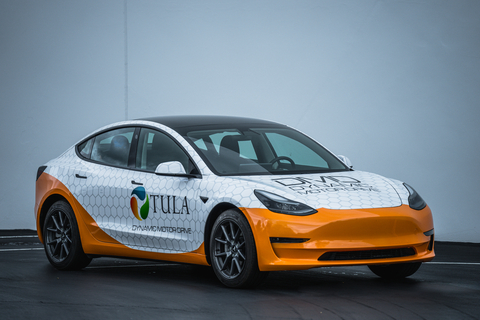Tesla Model 3 Retrofitted with DMD and EESM Available for Test Drives
Tula Technology, Inc., a leader in propulsion efficiency, will put its Dynamic Motor Drive® (DMD) technology into action at the 45th International Vienna Motor Symposium on April 24-26 in Vienna, Austria. Tula has retrofitted a Tesla Model 3 with an externally excited synchronous motor (EESM) running DMD software, and this innovative strategy will be demonstrated at the conference.
This press release features multimedia. View the full release here: https://www.businesswire.com/news/home/20240416986692/en/

Tula has retrofitted a Tesla Model 3 with an externally excited synchronous motor (EESM) running Dynamic Motor Drive® software. This innovative technology will be demonstrated at the 45th International Vienna Motor Symposium on April 24-26 in Vienna, Austria.(Photo: Business Wire)
Tula developed DMD to improve electric drive efficiency with a software-only solution. With an optimized pulsing strategy, DMD reduces energy consumption while having no perceptible impact on vehicle noise and vibration. Depending upon application, DMD with EESM can reduce energy consumption by up to 3%. This efficiency improvement can be directly translated into reduced battery size and cost, or alternatively, increased range.
Putting DMD to the test in a Tesla Model 3
Improved efficiency coupled with imperceptible operation is not only possible, Tula has now proven the feasibility of DMD in two vehicles with fundamentally different electric propulsion systems. In its latest effort, Tula retrofitted the permanent magnet synchronous motor (PMSM) in a Tesla Model 3 with a wound rotor to create an EESM. Tula then incorporated its proprietary DMD control logic to reduce energy consumption and improve overall system efficiency.
In 2022, Tula’s initial DMD application utilized a Chevrolet Bolt with an unmodified PMSM drive unit. Testing showed that DMD meaningfully improved the Bolt’s energy consumption while maintaining drive quality, demonstrating the value of DMD in PMSM applications.
DMD’s role in tomorrow’s powertrain
Improving the efficiency and lowering the cost of electric vehicle powertrains is one of the most critical challenges facing the automotive world today. Further, when developing powertrains for the future, manufacturers will increasingly seek to reduce their dependence on problematic rare earth elements. The combination of EESM and DMD supports that goal while being highly competitive in terms of both efficiency and cost. Although many motors will still be PMSM, Tula’s DMD technology also provides a high-value efficiency gain there. Overall, DMD is a scalable, adaptable, cost competitive and sustainable solution that makes electrified propulsion systems more efficient, accelerating the transition to an electrified future.
Members of Tula’s DMD development team will present a paper on their DMD findings at the Vienna Motor Symposium.
About Tula Technology, Inc.
Silicon Valley-based Tula Technology provides innovative award-winning software controls to optimize propulsion efficiency and emissions across the mobility spectrum, including electric, hybrid, gasoline, diesel, and alternative fuel vehicles. Tula’s culture of innovation has resulted in breakthrough technologies and a robust global patent portfolio of more than 400 patents issued and pending. Tula Technology is a privately held company backed by Sequoia Capital, Sigma Partners, Khosla Ventures, GM Ventures, BorgWarner and Franklin Templeton. More information is available at www.tulatech.com.
View source version on businesswire.com: https://www.businesswire.com/news/home/20240416986692/en/
Tula developed DMD to improve EV efficiency with a software-only solution. DMD with an externally excited synchronous motor can reduce energy consumption by up to 3%, which can be translated into reduced battery size and cost or increased range.
Contacts
Media: Financial Profiles
Tricia Ross
tross@finprofiles.com
310-622-8226
Investors: Financial Profiles
Julie Kegley
jkegley@finprofiles.com
310-622-8246






